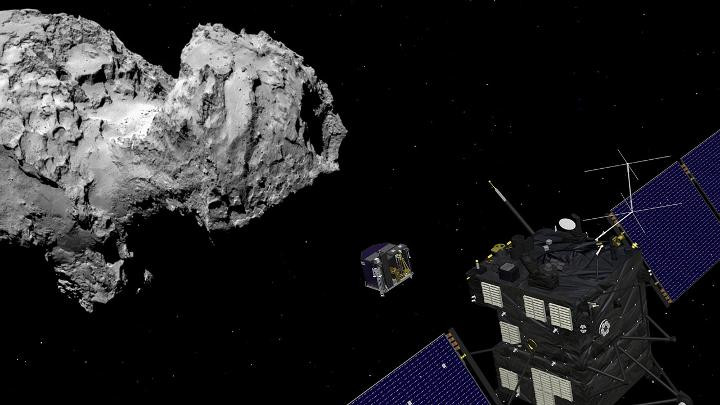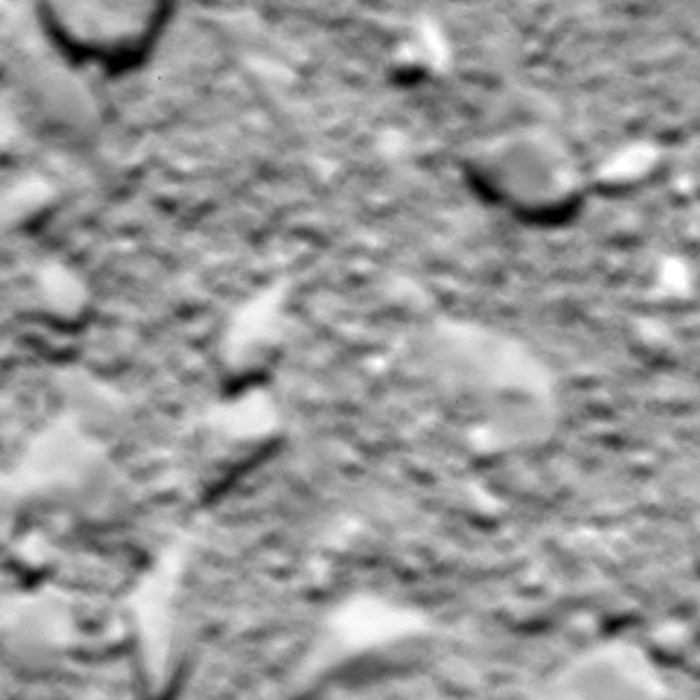Announcing the final images Rosetta captured before
Rosetta - the first spacecraft to arrive at an asteroid, ended its mission in 2016. ESA recently published images of Rosetta captured in the last moment in space.
In 2004, the European Aviation Agency (ESA) launched an ambitious space mission named Rosetta. The ship was designed to approach and study a comet as it entered the Solar System.

In 2016, the Rosetta probe put a landing craft on the comet surface of 67P and captured the image here.Now scientists are recreating the final image of the ship taken when it is only 20 meters above the comet surface.(Graphics: ESA / Rosetta / MPS for OSIRIS Team MPS / UPD / LAM / IAA / SSO / INTA / UPM / DASP / IDA).
In 2014, the ship reached the goal of comet 67P / Churyumov-Gerasimenko . For the next 17 months, Rosetta turned around this dusty ice globe and explored an object that had never been investigated before.
At the end of the mission, the Rosetta and comet 67P are increasingly leaving the Sun. Therefore, solar energy will not be enough to charge the ship and so scientists decided to end the mission with a controlled accident.
The ship will crash into the comet surface, which is also its final mission. On the free-falling road on comets, the ship will take photos and record as much data as possible and send it to Earth. Thanks to this brief moment we know more about 67P.
In 2016, Rosetta completed her final mission, sending a lot of scientific data regarding the dust, gas and plasma state of the comet. In this last flight, it has recorded a lot of images. But recently, scientists received a few more packets, and these are the final images of the end.

Rosetta took this image at a height of about 25 meters from the comet surface before it approached this object in a controlled crash.This is a raw image that has not been processed.(Photo: ESA / Rosetta / MPS).
In her final mission, Rosetta sent six data packets to Earth but the scientists received only three packages, the remaining three packages being interrupted so they could not be sent. When the raw image is sent, the scientists will proceed to process and output a clear image.
The compression software used on Rosetta ships makes images sent back to each layer rather than by pixel, which makes the image sent more blurry than half. The camera of the ship was taken mainly in the center of the photo, so that scientists could rely on it to reprogram the image into a full version.
The final image, although not providing much more scientific information for the experts, but it also marks a remarkable step of the people in the process of space mining.

The untreated rough image was taken by Rosetta when it was 20 meters above the comet surface as it fell here on September 30, 2016. To reconstruct the image now, the houses External research based on data recorded at the time, must also refer to the old data recorded before.(Photo: ESA / Rosetta / MPS).
During the course of the task, scientists have studied many important properties of this comet, from geological processes such as erosion and movement of dust, to cracks formed in the the crater, the movement of the rock or even the collapse of the cliffs to reveal the ice core inside.
Affirming the importance of the mission, project scientist Matt Taylor said: 'We will get an idea of where comets come from, as well as know how they are formed, and from it deduced the development of the Solar System, and further expanded. "

The final images of comet 67P were taken by Rosetta, the shooting positions are as follows.Top left corner: the overall picture when observing comets from a distance of 123km.Top right corner: view from 5.7km high above.Middle image: Images taken at an altitude of 331 meters above the surface.Lower right: The last image taken by Rosetta, at 24.7 ± 1.5 meters.Bottom left: The final image of comet shooting 67P, at an altitude of 19.5 ± 1.5 meters.(Photo: ESA / Rosetta / MPS).
Therefore, even though Rosetta has "died prematurely" in her mission, it is a pioneering step for our future missions. When the basic problems of comets are solved, we will answer the questions, such as: Can comets be exploited? Did they bring water to Earth? Just as is there a germ of life there or not?
Like most other cases, no matter what the answers to these questions are, these are still things we couldn't imagine before.
- Comet has been in the sights of Rosetta
- The final picture of Opportunity robot was captured and it hurt the online community
- ESA re-activated the comet probe Rosetta
- Reveal Rosetta's opponent
- The Rosetta probe will end its mission on September 30
- Rosetta spacecraft and 6 billion km journey to comets
- Awaken the comet 'hunter'
- Europe closed the day of landing on the comet
- European spacecraft approaches a duck-shaped comet
- Japan: Announcing real 3D images
- The surprising discovery about Rosetta's comet
- Announcing the design of space tourism
 Van Allen's belt and evidence that the Apollo 11 mission to the Moon was myth
Van Allen's belt and evidence that the Apollo 11 mission to the Moon was myth The levels of civilization in the universe (Kardashev scale)
The levels of civilization in the universe (Kardashev scale) Today Mars, the sun and the Earth are aligned
Today Mars, the sun and the Earth are aligned The Amazon owner announced a secret plan to build a space base for thousands of people
The Amazon owner announced a secret plan to build a space base for thousands of people